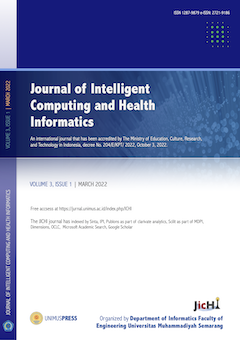Enhancing Agricultural Pest Detection with EfficientNetV2-L and Grad-CAM: A Comprehensive Approach to Sustainable Farming
(1) Department of Informatics, Universitas Muhammadiyah Semarang, Semarang, Indonesia
(2) Department of Informatics, Universitas Muhammadiyah Semarang, Semarang, Indonesia
(3) Department of Informatics, Universitas Muhammadiyah Semarang, Semarang, Indonesia
(4) Department of Informatics, Universitas Muhammadiyah Semarang, Semarang, Indonesia
(5) Department of Computer Engineering, Ardabil Branch, Islamic Azad University, Ardabil, Iran
(6) Department of Informatics, Universitas Muhammadiyah Semarang, Semarang, Indonesia
(*) Corresponding Author
Abstract
Full Text:
PDFReferences
Bouri, M., Arslan, K. S., & Şahin, F. (2023). Climate-Smart Pest Management in Sustainable Agriculture: Promises and Challenges. Sustainability, 15(5), 4592. https://doi.org/10.3390/su15054592
Dara, S. K., Rodriguez-Saona, C., & Morrison, W. R. (2023). Editorial: Integrated pest management strategies for sustainable food production. Frontiers in Sustainable Food Systems, 7. https://doi.org/10.3389/fsufs.2023.1224604
Dong, S., Du, J., Jiao, L., Wang, F., Liu, K., Teng, Y., & Wang, R. (2022). Automatic Crop Pest Detection Oriented Multiscale Feature Fusion Approach. Insects, 13(6), 554. https://doi.org/10.3390/insects13060554
Farooq, A., Farooq, N., Akbar, H., Hassan, Z. U., & Gheewala, S. H. (2023). A Critical Review of Climate Change Impact at a Global Scale on Cereal Crop Production. Agronomy, 13(1), 162. https://doi.org/10.3390/agronomy13010162
Gholami, R., & Fakhari, N. (2017). Support Vector Machine: Principles, Parameters, and Applications. In Handbook of Neural Computation (pp. 515–535). Elsevier. https://doi.org/10.1016/B978-0-12-811318-9.00027-2
Selvaraju, R. R., Cogswell, M., Das, A., Vedantam, R., Parikh, D., & Batra, D. (2020). Grad-CAM: Visual Explanations from Deep Networks via Gradient-Based Localization. International Journal of Computer Vision, 128(2), 336–359. https://doi.org/10.1007/s11263-019-01228-7
Tan, M., & Le, Q. (2021). EfficientNetV2: Smaller Models and Faster Training. Proceedings of the 38th International Conference on Machine Learning. PMLR., 10096–10106. https://proceedings.mlr.press/v139/tan21a.html
Tugrul, B., Elfatimi, E., & Eryigit, R. (2022). Convolutional Neural Networks in Detection of Plant Leaf Diseases: A Review. Agriculture, 12(8), 1192. https://doi.org/10.3390/agriculture12081192
Turkoglu, M. (2021). COVIDetectioNet: COVID-19 diagnosis system based on X-ray images using features selected from pre-learned deep features ensemble. Applied Intelligence, 51(3), 1213–1226. https://doi.org/10.1007/s10489-020-01888-w
Wen, C., Chen, H., Ma, Z., Zhang, T., Yang, C., Su, H., & Chen, H. (2022). Pest-YOLO: A model for large-scale multi-class dense and tiny pest detection and counting. Frontiers in Plant Science, 13. https://doi.org/10.3389/fpls.2022.973985
Wu, M.-E., Wang, C.-H., & Chung, W.-H. (2017). Using trading mechanisms to investigate large futures data and their implications to market trends. Soft Computing, 21(11), 2821–2834. https://doi.org/10.1007/s00500-016-2162-6
Zhang, L., Cui, H., Sun, J., Li, Z., Wang, H., & Li, D. (2023). CLT-YOLOX: Improved YOLOX Based on Cross-Layer Transformer for Object Detection Method Regarding Insect Pest. Agronomy, 13(8), 2091. https://doi.org/10.3390/agronomy13082091
Zhao, S., Liu, J., Bai, Z., Hu, C., & Jin, Y. (2022). Crop Pest Recognition in Real Agricultural Environment Using Convolutional Neural Networks by a Parallel Attention Mechanism. Frontiers in Plant Science, 13. https://doi.org/10.3389/fpls.2022.839572
Article Metrics
Abstract view : 306 timesPDF - 47 times
DOI: https://doi.org/10.26714/jichi.v5i1.13959
Refbacks
- There are currently no refbacks.
____________________________________________________________________________
Journal of Intelligent Computing and Health Informatics (JICHI)
ISSN 2715-6923 (print) | 2721-9186 (online)
Organized by
Department of Informatics
Faculty of Engineering
Universitas Muhammadiyah Semarang
W : https://jurnal.unimus.ac.id/index.php/ICHI
E : [email protected], [email protected]
This work is licensed under a Creative Commons Attribution-ShareAlike 4.0 International License.









